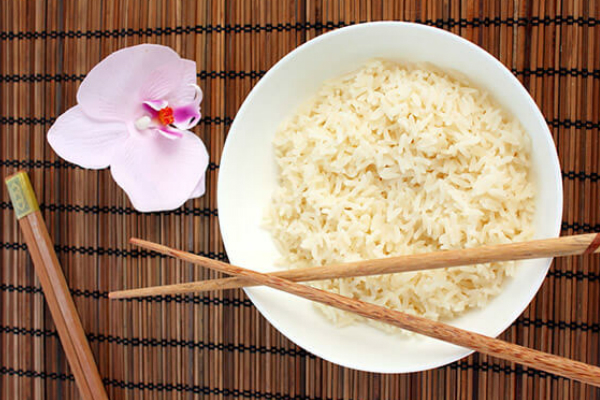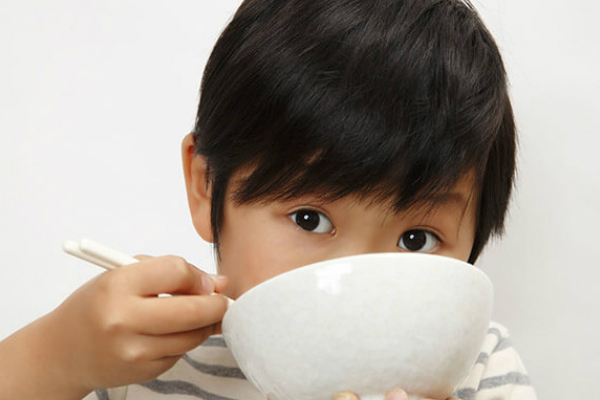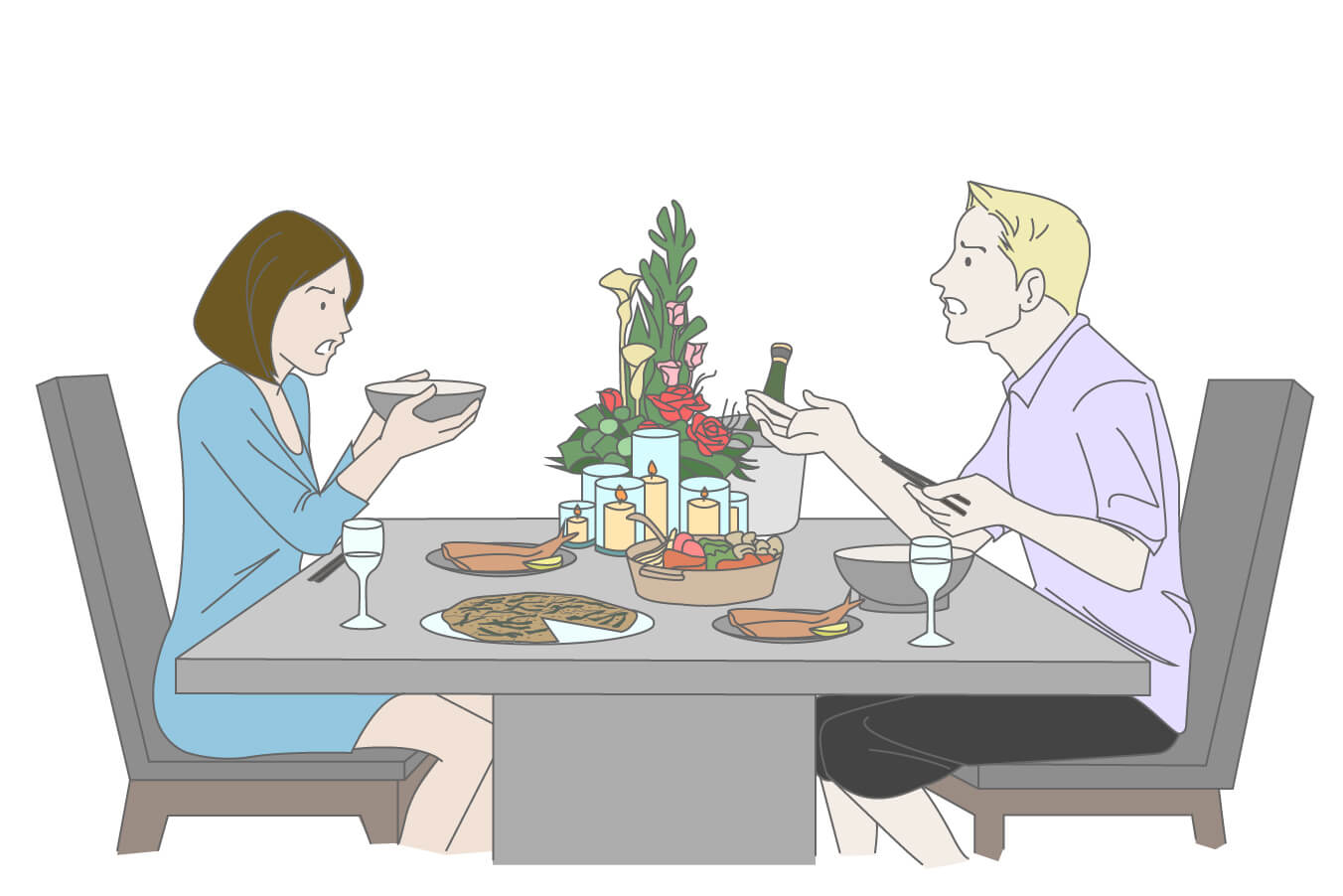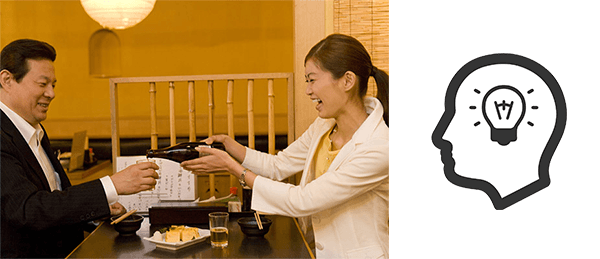INTRODUCE
Table manners are different in every culture. It’s helpful to explain Japanese table manners to your foreign friends who visit Japan.テーブルマナーは文化によって異なります。来日している外国人の友達に、日本のテーブルマナーについて説明することは役立ちます。

PRESENT
STEP A VOCABULARY
I. Listen and repeat.聴いて、リピートしましょう。

slurp音を立てて食べる |

burpげっぷをする |

talk with your mouth full口に物を入れて喋る |

cross your chopsticks箸を交差させる |

put your elbows on the tableテーブルに肘をつく |

pick up your bowl 茶碗を持ち上げる |
II. Which of the things above do you think are good manners? Which ones are bad manners?上記のうち、あなたが良いマナーだと思うものはどれですか?悪いマナーだと思うのはどれですか?

good manners

bad manners
III. Practice reading the words.単語を読む練習をしましょう。
 /cr/ |
 /cl/ |
|---|---|
cross 交差させる |
close 閉める |
crab 蟹 |
club クラブ |
crop 作物 |
clop (馬のひづめの)パカパカという音 |
STEP B GRAMMAR TIP
When two verbs are next to each other in a sentence, they usually follow one of two patterns:
- (verb) + (gerund)
- (verb) + (to-infinitive)
However, some verbs can use both patterns.
文中で2つの動詞が隣同士になった場合、次の2つのパターンのどちらかに従います:- 動詞+動名詞
- 動詞+to不定詞
-
You can use both pattern 1 and pattern 2 with the following verbs. The meaning is more or less the same.
次の動詞にはパターン1と2の両方使えます。意味はほとんど同じです。start
continue
prefer
hate
like
love
-
- I love slurping ramen.
- ラーメンを音をたてて、すするのが好きです。
- I love to slurp ramen.
- ラーメンを音をたてて、すするのが好きです。
-
You can use pattern 1 or 2 with the following verbs, but be careful: The meaning changes.
次の動詞にはパターン1と2の両方使えますが、意味が異なるので注意が必要です。remember
forget
stop
Use pattern 1, (verb) + (gerund), to show that the second verb happened before the subject stops, remembers, or forgets.
パターン1、動詞+動名詞では、二つ目の動詞の出来事は、stops、remembers、forgetsよりも以前に起きています。 -
- She visited this bakery twenty-five years ago and still remembers ordering their chocolate cake.
- 彼女は25年前にこのパン屋を訪れましたが、チョコレートケーキを注文したことをまだ覚えています。
- The boy’s mom yelled at him, so he stopped talking with food in his mouth.
- 少年の母が彼に怒鳴ったので、彼は口に物を入れて話すのを止めました。
-
Use pattern 2, (verb) + (to-infinitive), to show that the second verb happens after the subject stops, remembers, or forgets.
パターン2、動詞+to不定詞では、二つ目の動詞の出来事は、stops、remembers、 forgetsよりも後に起きています(起きます)。 -
- She remembered to order a chocolate cake for the party.
- 彼女はパーティー用のチョコレートケーキを注文することを覚えていました。
- The jogger’s friend waved at him, so he stopped to talk.
- 友達がジョギングしている彼に手を振りました。だから彼は話すために立ち止まりました。
UNDERSTAND
SPEAKING
Ai and Jake are having their anniversary dinner. Ai prepared a very special meal.
アイとジェイクは結婚記念日のディナーを食べています。アイは特別な料理を用意しました。
 |
- Jake:
Ai…
- Ai:
Yes, honey?
- Jake:
Could you please stop slurping your noodles? It’s so rude.
- Ai:
Slurping your noodles is rude in Canada, Jake. This is Japan.
- Jake:
Yes, but I’m Canadian.
- Ai:
Well, you love talking with your mouth full, but that’s rude in Canada too. You also like to put your elbows on the table. And do you remember burping during lunch yesterday? That was–
- Jake:
Okay, okay, I’m sorry! Let’s just enjoy the nice dinner that you made. I may not like watching you eat, but I love eating your cooking.
TRIVIA
Although it is considered bad manners in most countries, burping is actually polite in some countries like Bahrain and China. It shows that you enjoyed your meal and are full.
げっぷは、ほとんどの国でよくないマナーとされていますが、バーレーンや中国など国によっては礼儀正しいものと考えられています。げっぷは、料理を堪能し満腹であるということを示しています。

PRACTICE
STEP A EXERCISE
Complete the sentences using the pictures and words in the parentheses. More than one answer may be possible.
写真やカッコの単語をヒントにして、文を完成させましょう。答えは一つとは限りません。
|
1. I _____ years ago. |
|
2. I _____ on my plate. |
|
3. I _____ with a fork and knife. |
|
4. I almost forgot, but then I _____ for my boss at our party last night. |
STEP B EXERCISE
Complete the dialogue using the words in parentheses. More than one answer may be possible.
カッコの単語をヒントにして会話を完成させましょう。答えは一つとは限りません。
- Tutor:
This ramen tastes amazing!
- Student:
I noticed that you like (eat ramen with a fork).
- Tutor:
Yeah… Is that bad?
- Student:
Well, it’s not bad, but since you’ll be staying here for a while, you should start (use chopsticks).
- Tutor:
Okay. I’ll do my best.
- Student:
Remember (not cross your chopsticks). It’s considered rude.
- Tutor:
Oh, whoops. Sorry! By the way, do you also use chopsticks to eat curry? I think that’s really hard.
- Student:
Well, Japanese people usually prefer (use a spoon) for curry.

CHALLENGE
Challenge 1
You volunteered to be a tour guide for a small group of foreign tourists. It’s their first time in Japan.
あなたは、外国人グループのツアーガイドとしてボランティアをしています。彼らは初めて日本に来ました。
Take them to lunch and answer their questions about Japanese table manners.
ランチに連れて行き、日本のテーブルマナーについての彼らの質問に答えましょう。
Today's grammar tip
- (verb) + (gerund)
- (verb) + (to-infinitive)
 |
Challenge 2
Discuss your ideas. あなたの意見を言いましょう。
 If Time
If TimeAllows
1 TABLE MANNERS |
2 EATING JAPANESE FOOD |
3 FOOD CUSTOMS |
|---|---|---|
|
1 TABLE MANNERS
|
2EATING JAPANESE FOOD
|
3FOOD CUSTOMS
|
FEEDBACK
I can discuss good and bad table manners.テーブルマナーについて話し合えるようになる。
LESSON GOAL ACHIEVEMENT
-
4
Very GoodCould complete the task with ease
-
3
GoodCould complete the task with some clarifications
-
2
FairCould complete the task with additional instructions
-
1
PoorCould somehow complete the task with difficulty
PERSONALIZED FEEDBACK
-
RANGE
表現の幅
語彙をどの程度使えるか How well can you use vocabulary? -
ACCURACY
正確さ
文法が正しく使えているかどうか Are you using grammar correctly? -
FLUENCY
流暢さ
円滑に喋ることができるかどうか Are you able to speak smoothly?
 (stop / put my elbows on the table)
(stop / put my elbows on the table) (hate / leave food)
(hate / leave food) (love / eat pizza)
(love / eat pizza) (remember / pour a drink)
(remember / pour a drink)
